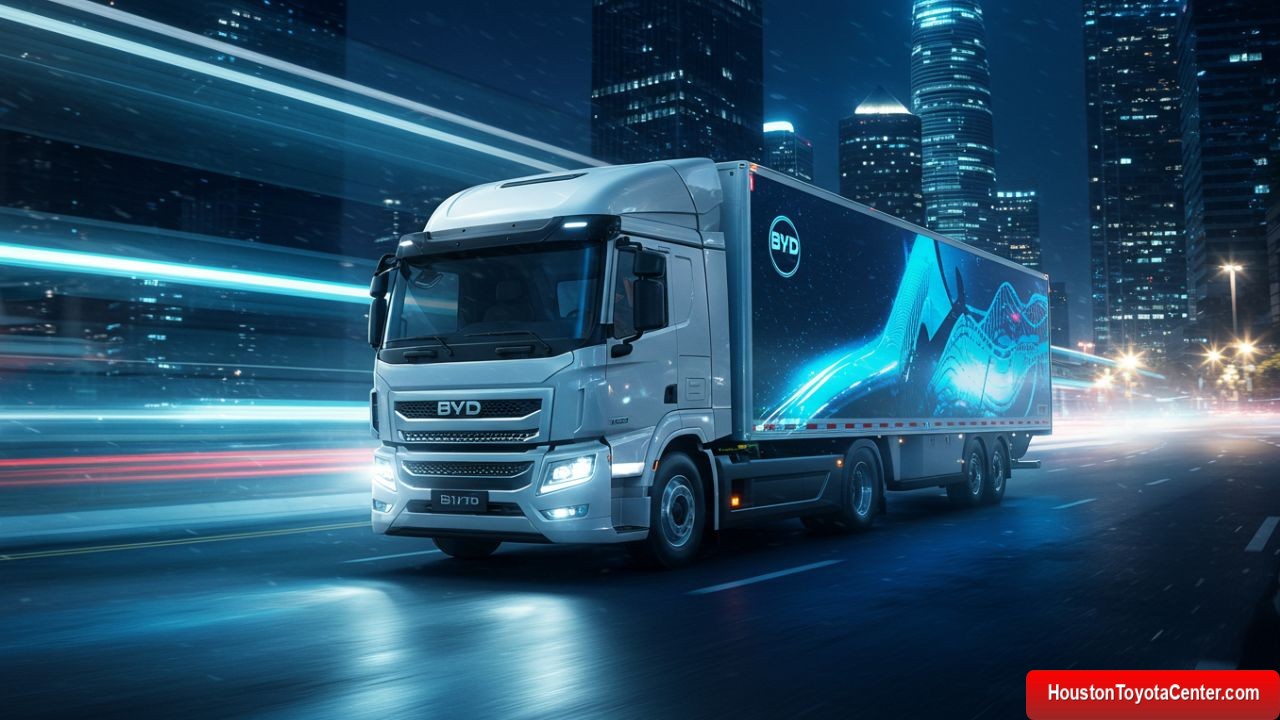BYD (Build Your Dreams), the Chinese electric vehicle (EV) giant, has become a dominant force in the global automotive market, known for its leadership in electric passenger cars and buses. However, in recent years, BYD has been rapidly expanding its footprint in the commercial vehicle sector, particularly in electric trucks. This shift reflects both the increasing demand for sustainable transportation solutions and the growing pressure on industries to reduce carbon emissions.
Electric trucks represent the future of work vehicles, promising lower operating costs, reduced environmental impact, and enhanced performance. BYD’s strategic move into this market is not just a business expansion — it’s a calculated response to global trends in electrification, logistics, and environmental regulation. This article explores BYD’s progress in electric trucks, the key technologies involved, market dynamics, and the challenges and opportunities that lie ahead.
1. BYD’s Strategy in the Electric Truck Market
BYD’s entry into the electric truck segment is part of a broader strategy to dominate the commercial EV market. While the company’s electric buses have already gained global traction, electric trucks offer an even larger market opportunity due to the sheer size and diversity of the logistics and work vehicle sector.
1.1. Product Lineup and Target Markets
BYD has strategically focused on a wide range of electric trucks to address various market needs, from light-duty urban delivery vehicles to heavy-duty long-haul trucks. Below is a summary of BYD’s current electric truck lineup:
FREE: Quickly identify and understand problems with your vehicle 🚘
CLICK HERE| Model | Type | Range (km) | Battery Capacity (kWh) | Payload Capacity | Market Focus |
|---|---|---|---|---|---|
| BYD T3 | Light-Duty Van | 300 km | 50.3 kWh | 1.0 ton | Urban delivery |
| BYD ETM6 | Medium-Duty Truck | 200 km | 105 kWh | 6.0 tons | Municipal services, construction |
| BYD Q1 | Heavy-Duty Tractor | 220 km | 200 kWh | 35.0 tons | Ports, industrial transport |
| BYD T8 | Heavy-Duty Rigid | 300 km | 282 kWh | 20.0 tons | Regional logistics |
| BYD 8TT | Heavy-Duty Tractor | 270 km | 325 kWh | 36.0 tons | Long-haul and regional transport |
1.2. Global Market Focus
BYD’s electric truck expansion is not limited to China. The company has strategically targeted major logistics hubs and urban markets across North America, Europe, and Southeast Asia. BYD’s trucks are already operational in:
- United States – Ports of Los Angeles and Long Beach have adopted BYD electric trucks for port operations.
- Europe – BYD has established partnerships with logistics companies in Germany, the Netherlands, and the UK.
- Latin America – BYD electric trucks are gaining traction in Mexico and Brazil, where governments are promoting cleaner transport solutions.
2. Core Technologies Behind BYD’s Electric Trucks
2.1. Blade Battery Technology
One of BYD’s key competitive advantages lies in its proprietary Blade Battery, a lithium iron phosphate (LFP) battery known for its safety, longevity, and efficiency. The Blade Battery offers:
✅ Higher energy density than traditional LFP batteries
✅ Longer lifecycle (up to 1.2 million km)
✅ Reduced risk of thermal runaway and fire
2.2. Integrated Powertrain Systems
BYD designs and manufactures its own electric motors, inverters, and transmissions, allowing for tight integration and performance optimization. This results in:
- Greater energy efficiency
- Lower maintenance costs
- Higher torque and better load-handling capability
2.3. Regenerative Braking and Smart Energy Management
BYD trucks feature advanced regenerative braking systems that recover kinetic energy and channel it back into the battery, improving overall efficiency. The smart energy management systems optimize power distribution based on load and driving conditions.
3. Market Forces Driving BYD’s Expansion
3.1. Regulatory Pressure
Governments worldwide are imposing stricter emissions regulations and offering incentives for the adoption of electric vehicles. Key regulations influencing BYD’s strategy include:
- European Union: Euro 7 standards to be implemented by 2027
- United States: California’s Advanced Clean Trucks (ACT) regulation
- China: New Energy Vehicle (NEV) quotas
3.2. Rising Fuel and Maintenance Costs
Electric trucks offer significant cost advantages over diesel-powered vehicles due to:
- Lower fuel costs (electricity vs. diesel)
- Fewer moving parts, reducing maintenance requirements
- Longer operational lifespan
3.3. Fleet Electrification Trends
Major logistics companies like UPS, Amazon, and DHL are committing to full electrification of their fleets by 2040. BYD’s ability to provide scalable electric truck solutions positions it as a key partner for these companies.
4. Challenges Facing BYD’s Electric Truck Business
4.1. Charging Infrastructure Limitations
Electric trucks require high-capacity charging stations, which are still underdeveloped in many regions. BYD has partnered with infrastructure providers to accelerate deployment.
4.2. Weight and Payload Limitations
Battery weight can reduce the payload capacity of electric trucks, especially for long-haul operations. BYD is addressing this by improving battery energy density and developing lightweight materials.
4.3. Competition from Legacy Automakers
BYD faces competition from established truck manufacturers like Daimler, Volvo, and Tesla. However, BYD’s cost advantages and early market presence provide a competitive edge.
5. Strategic Partnerships and Expansions
5.1. Joint Ventures and Manufacturing Plants
BYD has established joint ventures and manufacturing plants in key markets to reduce costs and improve market penetration:
- U.S.: Assembly plant in Lancaster, California
- Europe: Assembly facility in Hungary
- Latin America: Manufacturing partnerships in Brazil and Mexico
5.2. Fleet Trials and Pilot Programs
BYD has launched pilot programs with major logistics companies to refine its electric truck models and gather performance data under real-world conditions.
- Amazon is testing BYD trucks for last-mile delivery in Los Angeles.
- DHL has deployed BYD medium-duty trucks for urban logistics in Germany.
6. The Road Ahead: BYD’s Long-Term Vision
BYD aims to become the world’s largest manufacturer of electric trucks by 2030. Key elements of its long-term vision include:
🚀 Expanding the electric truck lineup to cover all market segments
🔋 Developing next-generation solid-state batteries for increased range and durability
🌍 Strengthening global manufacturing capacity to reduce costs and improve supply chain resilience
🤝 Expanding partnerships with governments and logistics companies to drive mass adoption
Conclusion
BYD’s expansion into electric trucks reflects a strategic shift that could reshape the commercial vehicle market. Leveraging its expertise in battery technology, electric powertrains, and manufacturing scale, BYD is well-positioned to capitalize on the growing demand for sustainable transportation solutions. While challenges remain — including infrastructure and competition — BYD’s aggressive growth strategy and technological edge make it a formidable player in the future of work vehicles. The rise of BYD’s electric trucks signals not just an evolution in transportation, but a broader transformation of the logistics and industrial sectors toward cleaner and more efficient mobility.


Leave a Reply